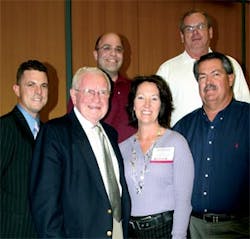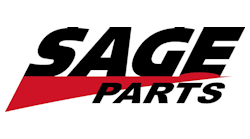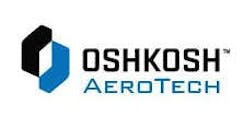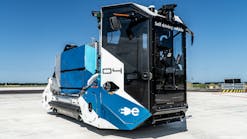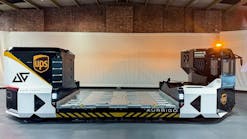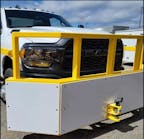Four years ago Ground Support Worldwide magazine realized it was time to show its support to the industry by recognizing a leader of the year (no, it was never called “Man” of the Year, as stated by some) and we took the next step by developing the “Ground Support Leader of the Year Award.” This year, recognizing there are leaders in several aspects of our industry, we expanded the award categories to include leaders in the areas of safety, environment, engineering and processes.
If Henry Ford could have joined us at the Ground Support Leaders of the Year awards reception last month in Dallas, he would have met five individuals in our industry who, because they never did take their eyes off of their goals, became the leaders they are today. I once heard someone say, “It’s not what you know, it’s what you do with what you know and it’s your attitude at the beginning of a task that determines success or failure.”
Each with their own style and all with their “can-do” attitudes, read for yourself why the following individuals were honored.
Green/Environmental Leader of the Year Award — for a person or a company that has introduced environmentally friendly equipment or processes.
Jody Lonergan began her career at Continental Airlines as an executive assistant and through the last 18 years has worked her way up through contracts and corporate GSE within the Airport Services Division.
Lonergan was chosen to receive the “Green/Environmental” award based on her knowledge of the environmental importance of implementing alternative fuels and the success achieved in reducing emissions.
Lonergan’s first contribution to the green movement at Continental was with her involvement in the Texas CIP and California MOU programs working as an analyst on the first inventory and emission calculations for the ATA negotiations.
Lonergan became involved with the equipment side of the green movement in 2000 when the first technology demonstrations were taking place at IAH. She participated on the committees that selected the vehicles, batteries and chargers that Continental eventually purchased.
Continental was one of the last major airlines to adopt electric vehicles; they waited and watched the technology evolve and observed the lessons other airlines were learning in their adoption of electric units. As the technology matured and electric vehicles were proven, Continental jumped in with both feet.
With her promotion to manager of corporate GSE for Airport Services, Lonergan took on a more active role in planning and executing the program to reduce emissions at Houston, Los Angeles, Newark, San Francisco, and many other smaller stations. It was her vision and drive that helped the company understand the need to use electric equipment to not only meet regulatory requirements, but exceed their standards due to the economic benefits realized by the use of electrics. “I’ll tell you, she is one of those workers where you either get moving or you get out of the way. She is a real go-getter. She has taken an active role in helping Continental become a breeder airline,” Dave Southern, senior director of airport operations, Continental Airlines says. “Two words describe Jody, she’s got vision and she’s got a lot of spunk … she really takes [her job] passionately.”
Under Lonergan’s leadership, Continental Airlines has converted almost 600 bag tugs, belt loaders and fork lifts to electric to save countless gallons of fuel and tons of emissions. In addition, Continental has developed partnerships in the industry to push the limits of the available technology to make the use of electric not just cost effective, but profitable.
Among her many other duties, it is Jody’s responsibility to employ new technologies to make the ramp safer and more efficient for the ramp agent. In 2005, she came up with a concept that had never before been tried at a major carrier. Seeing the utilization of large tractors to position baggage carts and freight around the airplane is neither easy nor efficient, she went looking for a new technology.She found it in the Charlatte T-208 which is a small, yet powerful electric tug that has a very good turning radius and is perfect for moving carts around an airplane where space is a premium. Continental has since deployed those tractors in several different applications, including maneuvering carts in and around the bag room. This has saved Continental a substantial amount of money in the operation.
Engineer/Innovator Leader of the Year Award — for a company or a person that has introduced a revolutionary product.
After earning a BS in chemistry with a minor in mechanical engineering and physics, Joe Hart started his career with the State of West Virginia on a highway tunnel project and after its completion, he joined Kersey Manufacturing designing electric mining equipment. These vehicles included mining scoops, loaders and tractors.
While at Kersey, Hart was approached by the airlines to investigate GSE opportunities. Eastern Airlines made a trip to Kersey and saw a mining tractor in the factory and asked if it could push an airplane. The answer was “yes,” and the electric pushback was born. More than 60 of these new electric vehicles were delivered to several legacy carriers, including international customers. In addition to the pushbacks, he designed a unique cargo transporter for Flying Tiger using the same Kersey electronics.
During his tenure at Kersey, Hart decided to try his luck in the fire truck business. At the time, American LaFrance was the sister company to Kersey and Joe was looking for a new challenge. Joe succeeded in this venture and was responsible for modernizing windshield design and bringing modular stainless bodies to the marketplace.
Hart came to Charlatte in 1993 and is now chief engineer and can be credited with designing tractors, several belt loaders, lavatory service trucks and a new generation of electric pushbacks. “Let me tell you, he is not a typical engineer where you walk in his office and see him playing solitaire,” Rob Lamb, Charlatte sales executive quips. “He is one of the few folks I know that can design a vehicle AutoCAD, weld a chassis and eventually help assemble the unit. Most engineers only engineer the vehicles — not Joe, he is involved in the entire process.
“He knows his way around the workshop, he can even get dirty. Joe is most likely so admired and respected in the GSE industry because he truly can design and build just about anything.” Even though Joe has been building electric equipment for 33 years now, come 5 p.m., all that hydraulic fluid comes off and he’s on the golf course.
Kaizen Leader of the Year Award — Japanese for continuous and incremental improvement, this award is for a person or company that has implemented a new business philosophy about business workplace practices, focusing on efficiency and improvement in productivity, performance or processes.
At a very early age, Mark Pollack, now president and chief executive officer of Sage Parts Plus Inc., was exposed to GSE and the aviation industry. As a child, Pollack would roam the halls of Airway Equipment (later Hudson General and now Servisair) where his father worked for more than 30 years and served in various capacities, including president and chief operating officer. Young Pollack would find himself working on the snow trailers, on the ramp, cleaning buses and eventually writing software for use in the operation.
Prior to purchasing Sage Parts in 1998, Pollack spent eight years as director of sales and operations developing and building a distribution network of high-end automotive paints for a division of Hoechst A.G. During this time he built a network of six warehouses, more than 100 technical sales personnel and 150 jobbers, and a customer base of more than 3,000 auto body repair facilities. He received recognition for his leadership and his organization’s high level of customer retention and satisfaction, as well as innovative marketing programs.
In 1998, when Pollack and business partner Michael Bloomfield acquired Sage, the company had fewer than five full-time employees and generated less than $3 million in annual revenues. Through his innovative approach, processes and use of technology, he was able to dramatically change the supply of GSE replacement parts. Today, just 10 years later, Sage Parts has become the leader in its space, with a team of 265-plus employees with operations in the US, Canada, Hong Kong and soon in Europe. In 2008, the company is expected to generate in excess of $80 million in revenue.
“This is the 10th anniversary of Sage Parts, so it’s very fitting that Mark is receiving this award,” Michael Bloomfield, major shareholder, Sage Parts proclaims. “Always finding ways to bring cost reduction and enhanced service improvement to its customers, Mark continually challenges his organization to re-think the way it does its business.
“He is reshaping the way GSE industry parts are sold and distributed throughout the industry. Through his innovative approach, processes and use of technology, he was able to dramatically change the supply of GSE parts, in essence creating an aftermarket which didn’t exist before.”
Safety Leader of the Year Award — for a person or company that has introduced a new method, procedure or product to improve industry safety records.
Shawn Mack began his career at Banyan Air Service located at Fort Lauderdale Executive Airport in 1996. For seven years he worked as a line service technician, then received a promotion to shift supervisor. In 2006, he was promoted to director of training, responsible for all phases of line service training procedures. In this role, Mack works closely with shift supervisors and line technicians to ensure that every technician performs to specific standards.
Through developing and refining procedures, raising the level of customer service and reinforcing policies, Banyan has experienced constant growth and change — so has Mack. He routinely meets with other FBO managers who participate in NATA training to discuss ways to improve procedures and increase safety, which has apparently paid off.
With a 10-year safety record of zero incidents or runway incursions, he was awarded an Airport Operations Area (AOA) award last year.
Annual training conducted by the airport administration and coordinated through Mack ensures that all 37 line service technicians and six customer support specialists are AOA certified, meaning they can conduct movements on the airport operations area and assist customers at customs. The current deficiency of experienced line service technicians has produced a challenge, making it necessary to train new technicians on the entire scope of line service procedures. However, Mack has risen to this challenge and his dedication to training is evident in the safety record of the line technicians Banyan employs.
“Safety is defined as averting injury, danger or loss. What greater goal is there in the role of safety for everyone in this industry?” Mack says. “During my 10 years as manager, I have concluded that the only way to successfully complete a task is to develop a standard, train employees and ensure that the standard is followed.”
With an average of 100 aircraft movements per day, Banyan needed a refined spotting procedure to improve aircraft movements. Without a standard for spotting aircraft and marshaling, the line technicians would perform these tasks differently. Mack worked with veteran teammates to expand their spotting procedure and developed a series of step-by-step actions which supplement the information in the NATA Safety 1st® training video. The new spotting procedure is conducted during training sessions and results in the tug drivers feeling confident in their spotters and an improved safety record.
His continued education includes the NATA “Train the Trainer” course and a leadership training course.
Team Leader of the Year Award — similar to the original Leader of the Year Award, this title is for an individual who has taken a leadership role with personnel.
Larry Laney began his career with Southwest Airlines in 1987 as the Dallas-region GSE foreman and was quickly promoted to various GSE manager positions prior to his current role, director of ground support for Southwest Airlines. With a total of 22 years in the GSE industry, Laney has a wealth of experience and is considered a true pioneer by his peers. According to friend and colleague, Debra Yates, Laney developed a very strong maintenance program at Southwest, in part because he surrounds himself with exceptional talent. However, according to Laney, “I guess the secret of being a great team leader is to have your team sit close to the beer. Honestly, I feel I have the best team in the industry.”
He has guided Southwest Airlines GSE through the many changes in equipment requirements from alternate fuel vehicles in Denver to electrification of the entire California fleet, required by the Environmental Protection Agency — all the while keeping a keen eye on Southwest’s bottom line. As a result of Laney’s leadership, Southwest Airlines has one of the most productive and efficient GSE operations in the industry.
Laney has been married for more then 30 years and has two children. He loves being a grandfather and is very proud of his two grandchildren. Laney enjoys golfing, riding his Harley and flying remote control planes.
